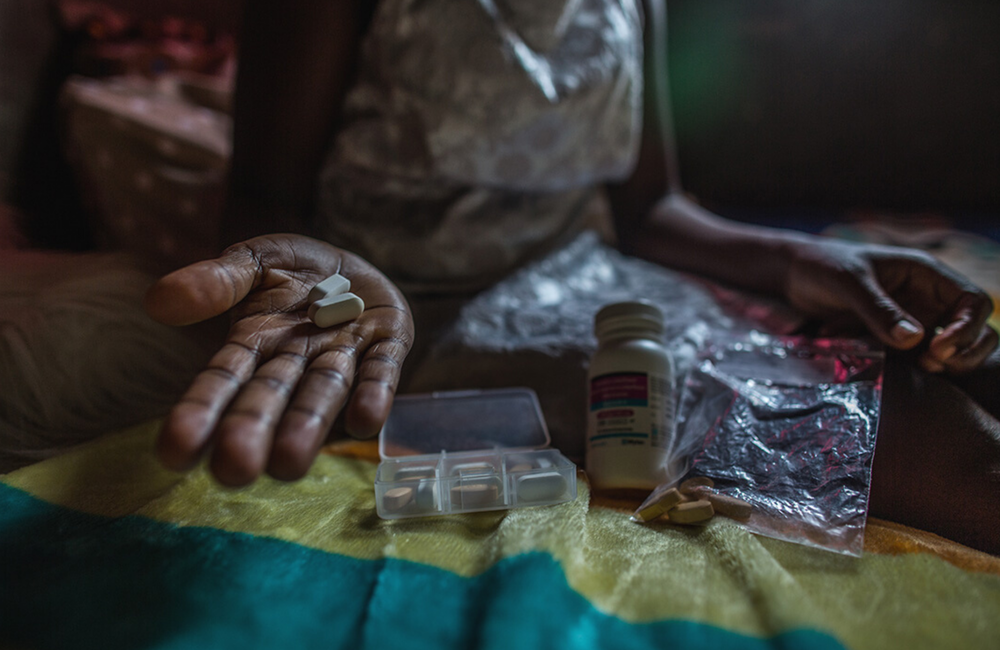
A study from 11 low and middle-income countries has found that uptake of dolutegravir, a highly effective antiretroviral medication, is lowest for women of reproductive age with HIV. Although similar proportions of men and women were receiving dolutegravir before May 2018, profound disparities rapidly emerged after that date and persist despite the World Health Organization's recommendation to expand its use to all adults and adolescents with HIV.
Led by Dr Matthew Romo of the City University of New York, researchers found that among patients starting treatment, only 20% of women aged 16-49 years were prescribed dolutegravir compared with 57% of men in the same age group. By the end of the follow-up (March 2020), dolutegravir uptake was 29% for women and 58% for men between 16 to 49 years. These findings are published in the January issue of Annals of Internal Medicine.
Background
Dolutegravir was first recommended in the World Health Organization (WHO) antiretroviral therapy (ART) guidelines in 2016. Evidence shows that HIV treatment containing dolutegravir is associated with improved viral suppression, less drug resistance, and fewer discontinuations compared with the previously preferred first-line regimen containing efavirenz.
In May 2018, just months after the WHO conditionally recommended dolutegravir as part of the preferred first- and second-line regimens for adults and adolescents living with HIV, a study from Botswana reported a higher risk of neural tube defects (birth defects of the brain, spine, or spinal cord) among infants of women who conceived while receiving dolutegravir. The WHO subsequently cautioned against dolutegravir use among females of reproductive age. Many countries and organisations issued their own policies about dolutegravir use, largely restricting access for most females of reproductive age.
In July 2019, based on additional reassuring evidence, the WHO once again recommended dolutegravir for all adults and adolescents living with HIV, including females of reproductive age regardless of contraception.
The study
The main aim of this observational study was to determine dolutegravir uptake by sex and age group.
From January 2017 through March 2020, the researchers examined health records of 134,672 patients at 87 facilities from 11 low and middle-income countries participating in the International epidemiology Databases to Evaluate AIDS (IeDEA). The countries were Brazil, Cambodia, Kenya, Rwanda, Uganda, Democratic Republic of the Congo, Haiti, Lesotho, Mozambique, Tanzania, and Zimbabwe.
The majority of the patients (52%) were females aged 16 to 49 years (defined as being of reproductive age), while 25% were males aged 16 to 49 years. Females and males aged 50 years or older were 13% and 10%, respectively.
The researchers calculated the proportions who had started dolutegravir at three time points: before the safety signal (until 18 May 2018), after the safety signal (until 22 July 2019), and after the WHO recommended dolutegravir for all (until 31 March 2020).
Dolutegravir uptake and differences by sex and age group
At the time of the safety signal, 3% of patients had initiated dolutegravir treatment, and differences by sex and age group emerged thereafter. By the time the WHO recommended dolutegravir for all, 16% among females aged 16 to 49 years had started dolutegravir, whereas 40% among males aged 16 to 49 years had done so. At the end of follow-up, uptake was 29% among females and 58% among males aged 16 to 49 years.
The disparities were greatest when comparing females aged 16 to 29 years (14%) with males aged 16 to 29 years (54%), and females aged 30 to 39 years (21%) with males aged 30 to 39 years (57%). The uptake of dolutegravir was similar among females and males aged 50 years or older.
In countries that began implementing dolutegravir treatment before the safety signal, uptake among females and males aged 16 to 49 years was 31% and 66%, respectively. In countries that began implementing dolutegravir treatment after the safety signal, the uptake of dolutegravir among females and males aged 16 to 49 years was 20% and 28%, respectively.
The disparity in dolutegravir uptake affecting females aged 16 to 49 years decreased after the July 2019 WHO recommendation of dolutegravir for all. The ratio before the recommendation was 0.40 (for every 100 men taking dolutegravir, 40 women did), and this increased to 0.51 (51 women for every 100 men) after the recommendation. The largest changes were among patients taking ART for the first time (0.27 before, 0.48 after) and among patients who began ART in 2016 or later, some of whom subsequently switched regimen (0.22 before, 0.40 after).
In Kenya, Tanzania, and Uganda – the only countries where pregnancy data were available - 4,873 female patients aged 16 to 49 years were pregnant during follow-up. Of the 619 starting ART, 92% started an efavirenz-containing regimen, 7% started a dolutegravir-containing regimen, and 1% started another regimen.
By the end of the study, 45% of patients were receiving dolutegravir, 43% were receiving efavirenz, and 9% were receiving a protease inhibitor. Efavirenz-containing regimens were most common among females aged 16 to 49 years (60%), whereas dolutegravir-containing regimens were most common for males aged 16 to 49 years (62%), females aged 50 years or older (62%), and males aged 50 years or older (66%).
Conclusion
“Our study found that profound disparities in the uptake of dolutegravir-containing ART affecting females of reproductive age emerged after the initial safety signal and persisted through early 2020, despite recommendations to expand its use to all adults and adolescents living with HIV,” say Romo and colleagues.
If sustained, the researchers say this disparity could have implications for HIV treatment outcomes in women because of the superior efficacy and tolerability of dolutegravir and its anticipated population health benefits.
“Equitable access to the most effective ART through alignment of clinical practice with evidence is an essential component to ending the HIV epidemic as a public health threat,” they conclude.
Based on these findings, Dr Andrea Ciaranello from Massachusetts General Hospital and colleagues note several key lessons for the public health community in an accompanying editorial.
- Informed patient autonomy – No single population should be universally denied safer or better therapies, and patients must be able to decide what is best for them. To enable informed patient autonomy, affected communities need to be involved in decision making and communication.
- Holistic analyses of risk-benefits of medications - Researchers and public health bodies need to conduct and effectively communicate holistic analyses of a wide range of risks and benefits for each treatment approach. The small increased risk for neural tube defects with dolutegravir needs to be considered in the context of the benefits including lower rates of neonatal death, preterm delivery, and treatment failure.
- Inclusion of pregnant people in clinical trials - When pregnant people first receive new medications through routine clinical care, potential risk is shifted to clinical settings without systematic monitoring or reporting, and thus the ability to understand risks is greatly reduced. Clinical trials including pregnant people can provide data on pharmacokinetics, dosing, some safety outcomes and efficacy in pregnancy.
- Robust birth surveillance systems - Robust studies based on large-scale surveillance systems with active reporting are urgently needed. Existing registries with passive data submission have incomplete reporting and may lead to overreporting of adverse outcomes.
Romo ML et al. Disparities in dolutegravir uptake affecting females of reproductive age with HIV in low- and middle-income countries after initial concerns about teratogenicity. An observational study. Annals of Internal Medicine 175: 84-94, 2022.
Doi: https://doi.org/10.7326/M21-3037
Ciaranello A et al. Time for a Change: Optimizing Drug Data and Informed Choice in Pregnancy. Annals of Internal Medicine 175: 133-134, 2022.
Doi: https://doi.org/10.7326/M21-4338
Full image credit: Loyce prepares her weekly pill box of Anti-Retroviral Treatment at her home in Chitungwiza. Morgana Wingard/Global Fund Advocates Network. Image available at www.globalfundadvocatesnetwork.org/2021-2022-speakers-bureau/we-need-the-global-fund-our-stories/ under a Creative Commons licence CC BY-NC 4.0.

